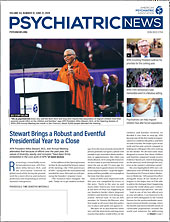Advocacy by APA and other mental health groups helped shape a final federal rule issued last month that allows psychiatric drugs to retain their “protected class” status in the Medicare Part D program. Current federal rules require Part D plans to include on their formularies all or substantially all drugs in the categories of antidepressants, antipsychotics, and anticonvulsants.
Last November, the Centers for Medicare and Medicaid Services (CMS) proposed a rule that would have weakened protected class status with three new exceptions: allow the use of prior-authorization and step therapy for protected class drugs, including indication-based formularies; exclude protected class drugs if the price increased beyond a certain threshold over a specified period; and finally, exclude drugs that represent a new formulation of an existing single-source drug, regardless of whether the older formulation remained on the market.
The proposal could have further limited treatment choices for psychiatric illnesses, so APA and other mental health advocates worked actively to thwart it, including submitting formal comments in January. (Other health care advocates also joined in the fight because the rule would have impacted other types of drugs as well.)
“We are pleased that as a result of APA’s advocacy and that of many of our district branches and the mental health community, this potentially harmful proposal was not codified into regulation,” said APA CEO and Medical Director Saul Levin, M.D., M.P.A. “With continued attacks on access to quality care, we remain concerned about efforts to increase the use of utilization management tools as a way to reduce health care costs, especially through prior authorizations. We will continue to work with our partners to advocate for a more streamlined, transparent, and consistent process that does not unduly burden physicians.”
APA opposed the proposed rule because of its potential for increased cost and harm to patients and concerns over increased physician burdens and interference with the doctor-patient relationship. Another reason was to preserve access to all psychotropic medications, since no two have an identical therapeutic effect.
APA was also active in 2014 in opposing efforts by CMS to repeal the protected class category entirely and successfully thwarted these efforts.
Under current policy, Part D plans may impose prior authorization and step-therapy requirements for protected class drugs only for enrollees who are initiating therapy and to confirm that the use of the medication is for a protected class indication. The final rule, issued last month, codifies this existing policy, which has been in effect since 2006.
CMS said the final rule is intended to provide more transparency regarding drug pricing, strengthen the plans’ negotiating leverage, lower prescription drug prices, and lower enrollees’ out-of-pocket costs. The final rule takes effect January 1, 2020.
Other provisions in the final rule are as follows:
•
Advise physicians about lower-cost therapies. By January 1, 2021, each Part D plan must adopt one or more electronic Real Time Benefits Tools that integrate with at least one prescriber’s ePrescribing system or electronic health record. These systems are designed to inform prescribers when a lower-cost alternative is available under an enrollee’s prescription drug benefit.
•
Inform enrollees about less-expensive drug alternatives. The Explanation of Benefits (EOB) that Part D plans send to enrollees must include information about an increase in the price of a drug they are taking as well as lower-cost therapeutic alternatives. This provision goes into effect in January 2021.
•
Prohibit gag clauses at pharmacies. Part D plans may no longer prohibit or penalize pharmacies that disclose to enrollees that a lower-cost cash alternative medication is available. ■
The CMS final rule, Modernizing Part D and Medicare Advantage to Lower Drug Prices and Reduce Out-of-Pocket Expenses, can be accessed
herehere.

